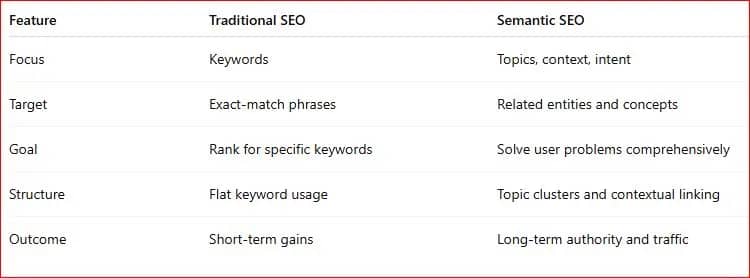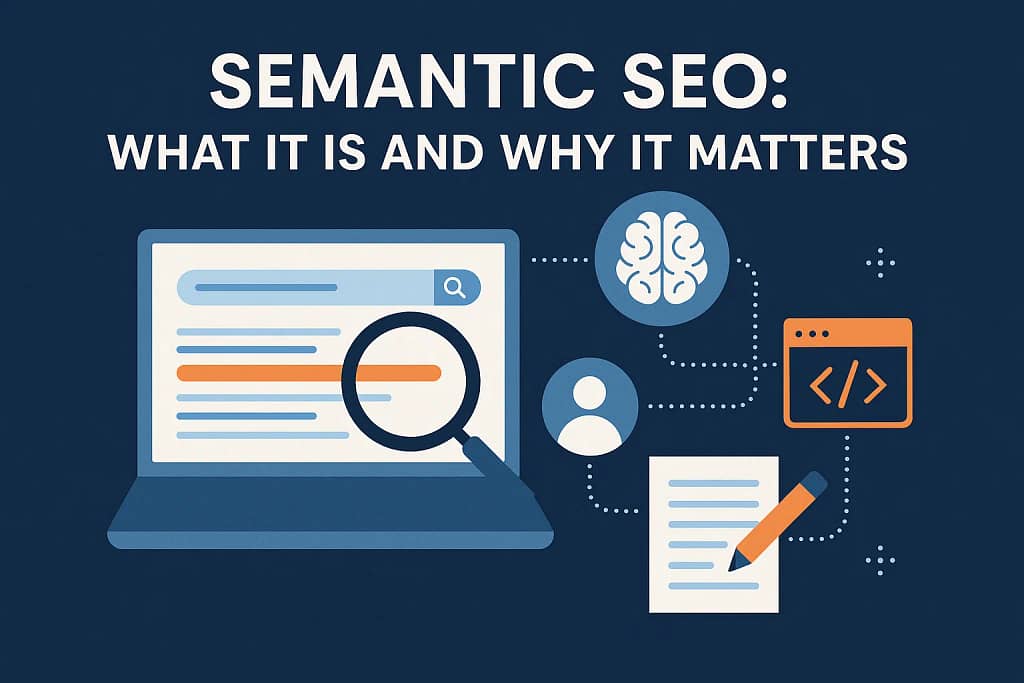In the ever-evolving world of search engine optimization (SEO), tactics that once worked—like keyword stuffing and exact-match domains—are becoming increasingly obsolete. Search engines, especially Google, have grown smarter. Today, they don’t just look for keyword matches—they strive to understand meaning, context, and intent.
This is where Semantic SEO steps in.
Semantic SEO represents a smarter, more strategic approach to SEO—one that aligns with how users search and how search engines process and interpret content. In this comprehensive guide, we’ll explore what Semantic SEO is, how it works, why it’s essential in 2025, and how you can implement it to improve your visibility and rankings.
What is Semantic SEO?
Semantic SEO is the practice of optimizing your content around topics, context, and user intent rather than focusing solely on exact keywords. It involves creating content that helps search engines understand the meaning behind queries and deliver more relevant results to users.
Unlike traditional SEO, which often relied on placing target keywords at certain densities, semantic SEO is about answering questions comprehensively, using related terms, entities, and concepts that reflect how people think and speak.
This concept became mainstream with major algorithm updates like:
Hummingbird (2013): Introduced the idea of semantic search by improving query understanding.
RankBrain (2015): Used machine learning to interpret queries, even those never seen before.
BERT (2019): Focused on understanding the nuance and context of words in search queries.
Search Generative Experience (SGE, 2023–2025): Moves towards conversational, AI-generated responses requiring deeper content comprehension.
These updates underscore one major truth: Google doesn’t just index keywords—it interprets meaning.
How Semantic SEO Works
Semantic SEO relies on search engines’ ability to understand:
Entities (people, places, things)
Relationships between these entities
Contextual meaning of words within sentences
Searcher intent
To achieve this, search engines use technologies such as:
1. Natural Language Processing (NLP)
NLP helps search engines parse and understand human language as it’s written or spoken. It allows Google to detect context, tone, synonyms, and even sentiment in a sentence.
Example:
If a user searches for “Apple,” NLP helps determine if they mean the fruit, the technology company, or even a music label—based on the surrounding words and user behavior.
2. Knowledge Graphs
Google’s Knowledge Graph connects entities and provides context about them. For example, if your content mentions “Steve Jobs,” “Apple Inc.,” and “iPhone,” it signals that your content is about the technology company, not the fruit.
3. Topic Relevance over Keyword Matching
Rather than optimizing a blog post just for the keyword “best SEO strategies,” semantic SEO ensures your post covers related topics like:
On-page SEO
Link building
Content clusters
Google ranking factors
Content optimization tools
This depth and breadth help Google assess topical authority.
Why Semantic SEO Matters in 2025
Search engines are no longer just matching words—they’re answering questions. And as AI continues to shape how search engines work (especially with SGE and voice search), semantic understanding is crucial.
Here’s why Semantic SEO is indispensable:
1. Aligns with User Intent: Users no longer type just keywords—they ask questions like they’re talking to a person. Queries like “How can I rank my blog higher in Google?” need meaningful answers, not just keyword-laden fluff.
2. Improves Relevance and Ranking: By focusing on contextual relevance, search engines reward content that answers the full scope of a user’s query. You’re more likely to rank for both short-tail and long-tail variations.
3. Increases Organic Traffic: Semantic-rich content tends to capture more featured snippets, People Also Ask (PAA) boxes, and even zero-click searches—all of which contribute to higher organic visibility.
4. Builds Content Authority: Covering a topic comprehensively shows Google that you’re an expert on the subject. It enhances E-E-A-T (Experience, Expertise, Authoritativeness, Trustworthiness), a critical part of modern SEO.
Key Elements of a Semantic SEO Strategy
Ready to start using Semantic SEO? Here are the core components you should implement:
1. Topic Clusters and Pillar Pages
This strategy involves creating one pillar page that covers a broad topic and multiple cluster content pieces that cover subtopics in detail, all interlinked.
Example:
Pillar Page: “Ultimate Guide to SEO”
Cluster Topics: On-page SEO, Technical SEO, Link Building, Semantic SEO, Keyword Research, etc.
This internal linking structure:
Enhances topical authority
Improves site navigation
Signals content hierarchy to Google
2. Optimizing for User Intent
Understand the search intent behind a query:
Informational: “What is semantic SEO?”
Navigational: “Ahrefs keyword tool”
Transactional: “Hire SEO experts”
Create content that satisfies each intent stage and guides users deeper into your funnel.
3. Use Structured Data Markup (Schema.org)
Structured data helps search engines understand your content more clearly and enables rich snippets in search results.
Examples of useful schemas:
Article
FAQPage
HowTo
Product
Review
This enhances search visibility and click-through rates.
4. Create Contextually Rich Content
Don’t stop at keyword targeting. Incorporate:
Synonyms and related terms
Latent Semantic Indexing (LSI) keywords
Common user questions
Internal and external links to trusted sources
Use tools like:
Frase.io – for semantic content briefs
Surfer SEO – for NLP-powered content scores
Clearscope – for optimizing relevance and depth
5. Optimize for Voice and Conversational Search
Voice search queries are longer and more natural. Incorporate conversational phrases and FAQ sections that align with how people speak, not just how they type.
Semantic SEO vs Traditional SEO: A Quick Comparison


Common Mistakes to Avoid in Semantic SEO
Even though semantic SEO is more sophisticated, mistakes can dilute its power. Avoid:
❌ Keyword Stuffing in Disguise: Don’t overload content with LSI terms just to signal relevance. This confuses readers and reduces content quality.
❌ Neglecting Structured Data: Skipping schema markup is a missed opportunity for enhanced visibility and richer search results.
❌ Ignoring Content Gaps: If you only cover parts of a topic, your content lacks depth. Use tools to identify related subtopics and questions users are asking.
❌ Weak Internal Linking: Failing to link related articles together breaks the semantic connection between content pieces.
The Future of Semantic SEO
Semantic SEO isn’t just a trend—it’s the future.
With Search Generative Experience (SGE) and AI-powered search assistants on the rise, search engines will increasingly reward content that offers comprehensive, conversational, and well-structured knowledge.
Upcoming trends to prepare for:
AI-generated answers favoring authoritative sources.
Voice and visual search powered by semantic understanding.
Zero-click searches where users get answers directly on the SERP.
Your content should not only rank—it should educate, engage, and convert.
Final Thoughts
The Search Engine Optimization (SEO) landscape is no longer just about ranking for keywords—it’s about creating meaningful, context-aware content that answers real questions.
By embracing Semantic SEO, you:
Future-proof your content against algorithm changes.
Create a better user experience.
Build authority in your niche.
Improve your visibility in SERPs beyond just blue links.

